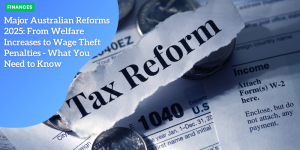How Australia’s Proposed Tech Tax Could Transform Digital News Revenue in 2024
Anúncios
Meta’s Refusal to Renew Funding Deals
The seeds of the deadlock between Meta and the Australian government were sown in March 2023 when Meta announced it wouldn’t renew its funding agreements.
These agreements, initially made reluctantly under the 2021 News Media Bargaining Code, involved payments of millions to major Australian news outlets.
When these deals expired, Meta chose to walk away, and the result has been six months of stalemate and mounting frustration on all sides.
Six-Month Deadlock
This deadlock has placed tremendous strain on Australia’s media landscape.
The government faces the uncomfortable dilemma of enforcing the News Media Bargaining Code, which required Meta to compensate news outlets for their content.
On the other hand, Meta’s withdrawal has left news outlets financially strained and highlighted the limitations of the current system.
The loss of revenue from Meta has rippled through news organizations, especially affecting smaller, independent publishers who relied heavily on these funds.
Meta’s Threat to Remove News Entirely
Meta’s maneuvering went beyond merely refusing to pay.
A chilling threat loomed over the proceedings: the complete removal of news content from Meta’s platforms in Australia.
This “nuclear option” would not only dry up a crucial revenue stream for news publishers but also severely reshape how Australians consume news on digital platforms.
Speaking to the parliament’s joint select committee on social media, Meta’s regional policy chief, Mia Garlick, underscored this by noting that “all options are on the table,” should the government resort to forcing compliance.
This threat echoes similar actions taken by Meta in other countries, such as Canada, where it pulled news off its local platform.
The Australian government has thus been cautious, keen to avoid a clash that could lead to news evaporation on Facebook and Instagram.
Yet, the stasis has necessitated new thinking and strategies, setting the stage for innovative solutions like the proposed ‘tech tax.’
As the dialogue evolves, it’s clear that the ripple effects of this confrontation are being felt throughout the media landscape, laying the groundwork for broader inquiries into how digital platforms should be regulated and leveraged for public good.
The Proposed Tech Tax Solution
A New Path Forward
Facing a mounting deadlock with Meta that has lasted six months, the Australian government is exploring a new course of action—a “digital platform levy,” commonly referred to as a tech tax.
This concept, recommended by a Labor-led parliamentary committee, could serve as a groundbreaking shift from the existing News Media Bargaining Code, promising to yield more sustainable revenue.
Breaking Down the Levy
The proposed digital platform levy aims to generate more revenue than the approximately $200 million accrued under the current News Media Bargaining Code.
Unlike the earlier code, which primarily involved deals negotiated with Meta and Google, the levy would cast a wider net over multiple tech companies and a broader range of services.
This comprehensive approach would likely make tax avoidance far more challenging.
Wider Application and Revenue Potential
By expanding the tax base, the government hopes to harness significant income from diverse digital services, beyond just news.
This involves taxing various online platforms, including social media giants, search engines, and potentially even streaming services.
If implemented effectively, this could eclipse the $200 million mark and create a more stable revenue stream for Australian news outlets.
Implementation and Adjustments
While specifics of the levy are yet to be finalized, the broad principle is clear: by taxing a more extensive array of digital services, Australia could set a robust precedent for handling tech giants.
This strategy mirrors measures already in place in countries like France, the UK, and Italy, boosting confidence that the model could be successful.
Shifting gears to a fairer, broader system could very well pave the way for a financially healthier and more diverse news ecosystem in Australia.
The question now lies in how swiftly and effectively these changes can be rolled out, setting the stage for ongoing discussions about revenue distribution and other critical adjustments.
International Context and Precedent
Existing Tech Taxes Around the World
The idea of taxing digital services isn’t new. A number of countries have already set up their versions of a tech tax.
Nations like France, the UK, and Italy have led the way by rolling out measures to tax major tech companies.
These taxes aren’t just directed at news content but cover a broader range of digital services, making them harder for companies to sidestep.
For instance, France imposed a 3% digital services tax on big tech firms in 2019, covering revenues generated from their digital activities.
Similarly, the UK’s Digital Services Tax, introduced in 2020, targets social media platforms, internet search engines, and online marketplaces.
Italy and Spain have enacted comparable regulations, ensuring that tech giants contribute more fairly to their national revenues.
Growing Global Interest
It’s not just a handful of countries that are keen on this approach. According to the EU Tax Observatory, an additional 19 countries are considering implementing similar measures.
This growing list includes nations from various continents, reflecting a global shift toward holding tech companies accountable for their substantial digital revenues.
These countries are watching closely how the tech tax plays out in early-adopter nations to fine-tune their own policies.
This widespread interest underscores the increasing awareness and political will to address the financial disparities caused by digital dominance.
Financial Impact of Tech Taxes
The financial implications of such tech taxes are significant. For example, France’s tax has already generated millions of euros since its implementation.
If Australia were to follow suit, it could potentially yield much more than the $200 million garnered by the current News Media Bargaining Code.
Crucially, this broader tax base means the revenue wouldn’t just come from interactions involving news.
This way, companies like Meta and Google, which threaten to pull news from their platforms, would still be liable under a digital services tax.
This approach mirrors the strategies employed by countries like India and Turkey, which have similarly expansive digital tax frameworks.
Understanding these international precedents is key.
They provide a roadmap for Australia, offering insights into the successes and challenges of implementing such taxes.
As the Australian government considers this path, the examples set by other countries could play a pivotal role in shaping its own digital platform levy.
Australia’s potential for a stronger, fairer revenue model sets the stage for the next crucial discussions on ensuring equitable and supportive measures for all media sectors.
Distribution and Benefits
One of the standout features of the proposed tech tax is its dedication to supporting small, independent, and digital-only publishers.
Unlike the News Media Bargaining Code, which had limited distribution scope, this new levy intends to cast a wider net in its financial support.
Ensuring Sustainability for Small, Independent, and Digital-Only Publishers
The digital platform levy is designed to distribute revenue in a way that promotes media diversity.
The Labor-led parliamentary committee emphasized that small, independent, and digital-only publishers stand to benefit significantly from this proposal.
These publishers often lack the financial clout of larger media organizations, but they provide essential local news and perspectives that enrich our democratic dialogue.
With additional funds, these smaller outlets can sustain their operations and possibly expand their reach.
Emphasis on Rural, Regional, and Remote Area News Outlets
Another critical benefit of the tech tax proposal is its focus on supporting rural, regional, and remote area news outlets.
These areas are frequently underserved by major media corporations, leaving residents without essential local news coverage.
A fair distribution of the tech tax revenue aims to invigorate journalism in these often overlooked regions, bringing a renewed focus on local stories and issues.
Fair Revenue Distribution
The proposed system aims to institute a more equitable model for revenue distribution.
This could involve a sliding scale or merit-based criteria to ensure funds are allocated fairly.
The goal is to help maintain a robust and diverse media landscape where multiple voices are heard and valued.
The committee has yet to finalize the exact mechanism for this, but its commitment to fairness and sustainability is a promising sign for the future of Australia’s media industry.
As Australia weighs the benefits of the new tech tax, the government’s clear shift towards supporting a diverse and resilient media environment becomes evident.
Political and Policy Implications
Government’s Shift
The Australian government’s move away from the News Media Bargaining Code signifies a pronounced shift in its approach to digital media regulation.
Faced with Meta’s refusal to renew funding deals and the company’s threat to remove news from its platform, the government found itself in a six-month deadlock.
This standstill prompted it to explore alternative solutions such as a digital platform levy.
This pivot signals a reevaluation of the efficacy of the existing code, which, while generating some revenue, may no longer be adequate for contemporary challenges.
Coalition’s Opposition
Not everyone is on board with this new direction.
The Coalition remains strongly opposed to abandoning the current News Media Bargaining Code.
They argue that the code has been successful in generating revenue and fostering negotiations between tech giants and news outlets.
According to Coalition committee members, the claim that the code is no longer fit for purpose is unfounded.
They worry that a shift to a tech tax could destabilize the fragile balance that has been achieved and cause more harm than good.
Implementation Challenges
Introducing a tech tax is far from straightforward. The government must navigate multiple hurdles before the levy becomes a reality.
Firstly, defining the scope and structure of the tax to ensure it targets the right companies without stifling innovation or business operations is crucial. Secondly, creating a fair and transparent system for revenue distribution poses a significant challenge.
The government intends to focus on supporting small, independent, and digital-only publishers, especially those in rural, regional, and remote areas.
Establishing such mechanisms, however, requires meticulous planning and coordination.
Finally, the potential backlash from tech companies could further complicate the issue.
As seen in other countries, some companies might respond by withdrawing services or content, which would undermine the tax’s objectives.
Despite these obstacles, the government is determined to proceed, albeit cautiously.
The introduction of a tech tax could mark a transformative change in Australia’s media landscape, potentially leading to a more sustainable and diverse media ecosystem.
The next steps will require strategic policymaking to balance various interests and navigate complex implementation phases.
This policy evolution paves the way for more comprehensive solutions to ensure the vitality of Australia’s media sector.







